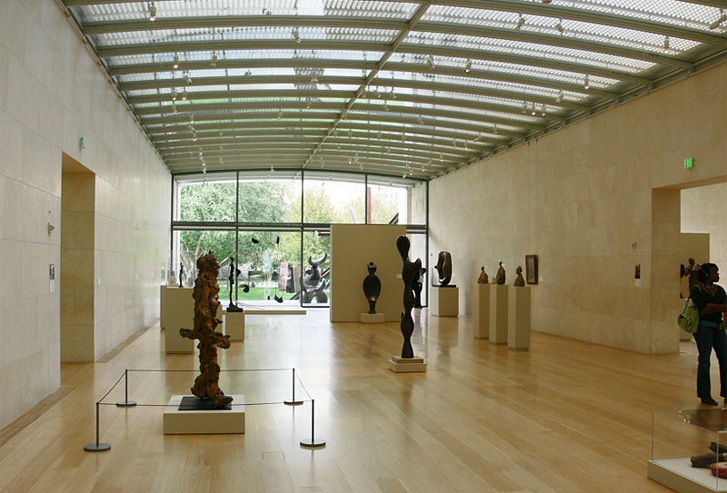You’ve heard of the architecture’s Pritzker Prize, Britain’s Turner Prize, the Guggenheim’s Hugo Boss Prize, and of course the various Nobel Prizes. This afternoon the Nasher Sculpture Center announced its own addition to the prestigious international cultural prize circuit, the Nasher Prize. The Nasher Prize will be given annual to a “living artist in recognition of a significant body of work that has had an extraordinary impact on the understanding of the art form.”
Apparently years in the making (dating back to a dream of Ray and Patsy Nasher to launch such a prize), a jury of seven rather heavy-weight jurors will convene in London this summer to determine the very first honoree. The announcement will take place in the fall, and the award will be bestowed amid celebrations next spring, including public lectures, symposiums, and special educational programming. The award will come with $100,000 cash.
At the announcement this afternoon, Nasher director Jeremy Strick spoke about the opportunity for the Nasher to put its “finger on the pulse of sculpture” and extend the “historical record of brilliant accomplishment in the field.” Mayor Mike Rawlings and Nancy Nasher also spoke at the event, the former highlighting the way the new prize could bring attention to the city of Dallas and help shore up its reputation as a place of global importance.
The new prize is an interesting gambit on the part of the Nasher Sculpture Center. As a rare institution dedicated exclusively to sculpture, it is uniquely positioned to launch such an award. And the award does seem to represent an attempt by the museum to better position itself as a recognized authority on the international stage. There was no shortage of references to this authority, the international scope of the prize, and the desire to help the city of Dallas bask in this limelight during the event. Prizes like these, after all, are useful branding tools, ways to extend curatorial reputation by funneling curatorial acumen through a marketable event.
But prizes can help elevate the career of an artist and push a critical dialogue around an artistic practice. Particularly in the case of the Turner Prize, what is always as interesting (if not more interesting) than who wins the award each year is the spirited debate and inevitable dissatisfaction that accompanies the announcement of the short lists and the winners. If the Nasher Prize can stir up that kind of robust dialogue around contemporary sculpture, then it will be a welcomed addition to the international art landscape, no matter where the host institution happens to be located.
In fact, it is precisely because sculpture at this particular moment is such a difficult to pin down medium that the Nasher Prize may actually, perhaps more than the other prizes of its kind, have something to say. Listed in the litany of great sculptors listed during the event (including Henry Moore, Jean Arp, Brancusi, Giacometti, etc) were the “social sculptors” Joseph Beuys and Rick Lowe. These two represent only the very tip of the iceberg with regards to the possibility of interpreting the scope and breadth of three dimensional art making. Depending on how boldly its jurors seek to make distinctions and definitions around what kind of artist a Nasher Prize should honor, the new award could provoke or disrupt expectations, deepen a critical conversation, and raise public awareness around the nature and meaning of sculpture. If it does, then it could become a prize that deserves notice.
The seven member jury is certainly recognizable:
Phyllida Barlow, artist; Lynne Cooke, Senior Curator of Special Projects in Modern Art, National Gallery of Art; Okwui Enwezor, Director, Haus der Kunst; Yuko Hasegawa, Chief Curator of the Museum of Contemporary Art, Tokyo (MOT); Steven Nash, founding Director of the Nasher Sculpture Center and Director Emeritus of the Palm Springs Art Museum; Alexander Potts, art historian; and Sir Nicholas Serota, Director, Tate.
I would have liked to see a few more artists on that list, but perhaps they can balance it out in subsequent years.
So what will this mean for the Nasher?
As it stands today, the Nasher is still best known for its very strong collection of modernist sculpture, as well as its renowned museum building, Renzo Piano’s architectural gem. Under Jeremy Strick the Nasher has shown willingness to push at the boundaries of its core mission, exhibiting a broad range of contemporary artists who relate to, extend, or, in some cases, challenge the expectations for sculpture suggested by its permanent collection. Its rooted-ness in the tradition, however, that can sometimes feel like a drag on its curatorial vision, making the Nasher feel overly safe. The museum likes to point to Nasher XChange as it s moment of real “outside the box” curatorial practice (as it did during the event today), however, Rick Lowe aside, the diversity of approaches, inconsistency of execution on the part of the artists, and limited dynamics of public interaction throughout the various sites made it something of a mixed success.
The Nasher Prize, after Nasher XChange, is the second major attempt at pushing the museum into a broader international conversation. If the new prize follows through on the dictates of the museum’s stated ambition, then it could change the way the museum is seen. Its authority, however, will also be a function of how well the museum’s curatorial practice can prove that it really is on the cutting edge of the medium it champions.






